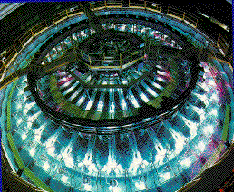May
13
A Fusion Power Breakthrough
May 13, 2010 | 9 Comments
Noted physicist Dr. Franklin Felber leading a research team at Sandia National Lab in Albuquerque has taken a big step towards meeting two of the greatest technological challenges of pulsed power for fusion – current amplification and pulse compression. Fusion, particularly inertial confinement fusion, requires that tremendous power be concentrated almost instantaneously into the fuel.
Dr. Michael Cuneo, Manager of the Radiation and Fusion Experiments Group at Sandia said, “These are surprising and unexpected results and if confirmed by future experiments could shorten the time scale and lower costs to reach pulsed power-driven nuclear fusion. Discovering this unexpected combination of current amplification by flux compression and pulse sharpening by a naturally occurring plasma opening switch was a lucky accident.”
The team’s discovery was published in Physical Review Letters.
Felber’s research team had been attempting to boost the power that could be delivered to fusion targets by fastening small cartridges they’d developed for Sandia’s enormous Saturn pulsed power generator. The cartridges worked better than hoped, doubling the generator’s current. But the researchers nearly overlooked the part of the results, because the dramatic boost in electrical power occurred unexpectedly, only long after the Saturn generator pulse had ended.
The team is theorizing that material heated off the cartridge walls blocks the initial current pulse, allowing electrical energy to build up inside the cartridge before releasing the energy suddenly into the target volume. Perhaps they designed a capacitor sort of thing without realizing it.
Here’s the major plus – the high-power pulses from low-power generators could result in substantial electrical power savings in future fusion power plants, increasing net efficiency.
The cartridges developed by the research team to amplify currents surprisingly also acted as very effective plasma opening switches, storing up electrical energy for a time much longer than the Saturn generator pulse, and then releasing the energy into the target volume in a time shorter than the Saturn generator pulse. The development may answer 30 years of research around the world by researchers who have also been trying to develop high-power plasma opening switches that could store up electrical energy in a magnetic field and then release the energy suddenly onto a target.
Dr. Felber said, “Discovering this unexpected combination of current amplification by flux compression and pulse sharpening by a naturally occurring plasma opening switch was a lucky accident. I hope these advances are put to use quickly to help solve some of the challenges we face meeting this nation’s power needs in a sustainable manner.”
Dr. Felber led a research effort sponsored by the U. S. Department of Energy and including scientists at Sandia and in the former Soviet Union during the mid 1980s. The team showed that hot ionized gas, called plasma, could ‘pinch’ a magnetic field to what was then the highest value ever produced inside a laboratory, about a hundred million times greater than the Earth’s magnetic field. Since then, research teams around the world have been trying to use this method of plasma ‘magnetic flux compression’ to amplify the high electrical currents needed for fusion.
Dr. Alexander Velikovich, Research Physicist at the U.S. Naval Research Laboratory in Washington, D.C., and one of the former Soviet scientists who was a pioneer with Dr. Felber in magnetic flux compression nearly 30 years ago said, “The results of these new experiments on the Saturn generator show great promise for the potential of magnetic flux compression to achieve the high electrical powers and short pulses needed for fusion drivers.”
Dr. Farhat Beg, Professor of Engineering Physics at the University of California, San Diego, who has been collaborating with Sandia on pulsed power experiments remarked, “The work reported here seems to be a significant technological advance in flux compression and opening switches that could potentially accelerate development and reduce capital costs of future fusion power plants.”
The information release isn’t addressing the progress on the fusion device. But across the spectrum from the small led by Eric Lerner and the Nebel led Bussard team to the massive ITER, handling power is a major engineering issue. Felber’s work may answer some bedeviling problems for many efforts.
The Saturn accelerator is a device to produce X-rays with a symmetrical implosion event. The idea is Saturn’s magnetic pulse is timed so that it peaks precisely when the plasma field is most symmetric, thus yielding a more uniform implosion. That’s how very high X-ray outputs are achieved. When the plasma stagnates on the target area’s axis, a more uniform plasma produces a shorter — and more powerful — X-ray pulse.
It’s been rather quiet since 2008 at Sandia on the fusion front. Perhaps with the cartridges sorted out the likely backlog of ideas can get underway with testing. Let’s hope the team gets the full understanding of what’s going on inside the cartridges as well and gets the information out – as others may well make good use of the breakthrough.
Comments
9 Comments so far



[…] A Fusion Power Breakthrough | New Energy and Fuel […]
Hey this is a great post. Gave me a lot of information I needed to know and I knew things I would have never guessed on my own.
This is great news. The ability to control and release more intense bursts of power will push focus fusion and polywell fusion that much closer to break even.
Great information! I’ve been looking for something like this for a while now. Thanks!
[…] Read full story document.write(""); […]
It’s been rather quiet since 2008 at Sandia on the fusion front.
Couldnt agree more with that, very attractive article
The information release isn’t addressing the progress on the fusion device. The cartridges worked better than hoped, doubling the generator’s current.Thanks for this 😉
No problem it will result in electrical power savings in the future.